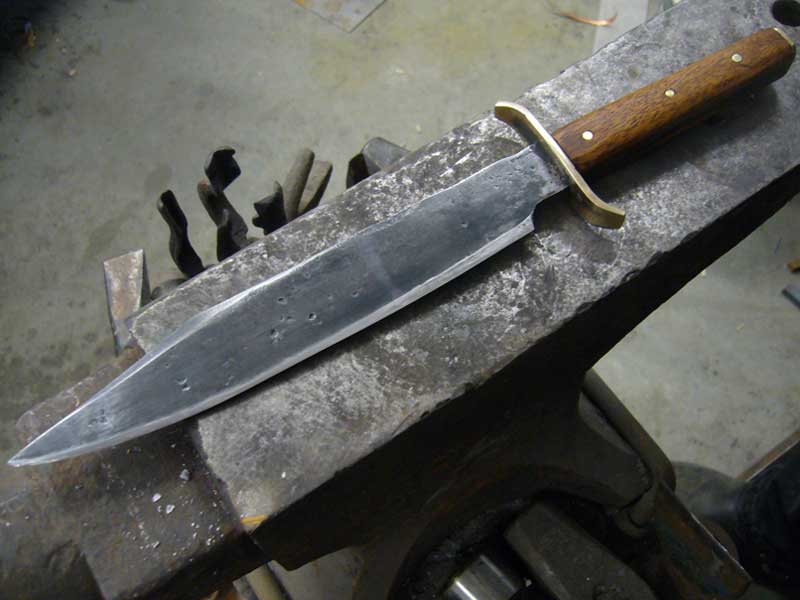http://www.harborfreight.com/55-Lb-R...vil-69161.html
The Harbor Freight anvil is soft, but I doubt it is pure cast iron, but most likely cast steel in the 2% carbon range. It's $64 btw and stumpy enough to do knives if hardened. The way to test it is to try and weld a piece of steel to a small part of the bottom, if high carbon like most castings are the weld will crack. If it doesn't crack but welds, then grind it off and take it back to HF
or get a piece of 1/8" 17-4 PH stainless and weld it to the top, 1/4 would be better, but it's expensive. The PH stands for prehard. I do not know how hard it is (200,000 psi), but it had to be annealed for me to punch large holes in it, it's hard, but not knife hard, more like spring hard and very very
very tough. Just stitch weld it and when it eventually gets dinged up, you can cut it off and turn it over, Heck if the anvil's soft you can even drill and tap 6 holes on the perimeter in the anvil and screw the 17-4 PH down or even a piece of 1/4 5160 HT to 40-50 hard. Lots of ideas after the guys above told me what they did. (use hardened screws)
I had a 4 ft. by 5 ft. cast iron ground flat (.006 OA) surface plate for my welding table at my last job. It was soft, but I made some threaded 3/4-16NF holes in it for clamping parts down and torched the holes and they got hard really fast. You can take an oxy/acetylene torch and harden the surface of this cast anvil one spot at a time with a rosebud tip. Just bring it up to a dull red and let it cool. Don't try to do more than a few spots at a time and jump around, letting it cool between HTs. Stay about 1/2 inch from the edges. Be sure and finish the surface with a file/sandpaper before HT. Just an idea for the monetarily challenged. $350 for a light rusty old anvil with no markings? Gadzooks!
The way to mount these is to get a piece of 1/2 inch round rod and thread the ends 1/2-13NC or even better, 1/2-20NF. And bend it into a squared U-bolt to match the holes in the foot. This is what I meant above by clamped down. The base can be wood, but really thick wood, 3/8" plate is preferable with heavy walled tubing for the legs. You can do a one sided hook or double sided, for a small anvil double is better.
Here is a partial look at a mounting, these pics are like 2002-3. This old anvil needed to be resurfaced, but it was soft and got work hardened brittle on the cutting table step by a lying idiot my brother hired, we actually used it for cold forging mostly. Note the heavy tubing it's sitting on, the 100 pounder was bolted to the floor as well with carpet as a cushion on the tube legs which had plates welded to the feet for the floor bolts. Not too thick and not too thin. A cheap MIG welder is all you need and you chamfer all the weld joints. A cheap DC TIG is better, but needs more skill. Something I'm willing to teach to anyone within driving distance with gas money, dinner's OK too.
My brothers web site is, Themetalguy.com, if you want a look at what we did there, like him standing next to a metal gazebo at the lake was a picture I took, Bill gates' winter place. (Palm Springs, CA) My brother billed himself as "Blacksmith Artist". A lot of the metal art was just shapes that rich people paid $1000's for and we just made up. LOL! The hard stuff was when they wanted something specific even though weird. I'm more of a technician than an artist, brother was opposite. Handle btw is drop offs Mesquite from a mansion with 4,000 square feet of mesquite flooring to please his wife cuz she liked it. LOL
I added another mounting solution. As I stated above, for lighter anvils mounting makes a big difference, tree trunks are fine for the 200+ pounders, but they have to be done right too. That knife looks like a rookie forged it, must be my brother's knife.LOL

Here is a different mount, but shows what I mean. Though I wouldn't mount an anvil like that on such a post. But for $75 I would snap it up. Notice the Hardie chisels on both. That is how I cut my last billet of Damascus. A nice convex edge is best like an axe. This must be an old pic judging by the prices. You can try and wait for a deal like this, but should make do with the best you can do. Never go to an auction Goater without a small pocket hammer. Note the bottom anvil would probably be better for forging knives from what the guys said above. Remember there is a catch to old anvils, parts of them may be work hardened brittle like the top anvil on the edge of the cut step. You want at least 6"x4 hammering surface btw, smaller and you will spend a lot of time looking down the blade to make sure it isn't curling. I like a 4' by 12" anvil top to lay the blade down and see where I am, no line of sight guessing and I'm good at it.

Anything to add fellas?